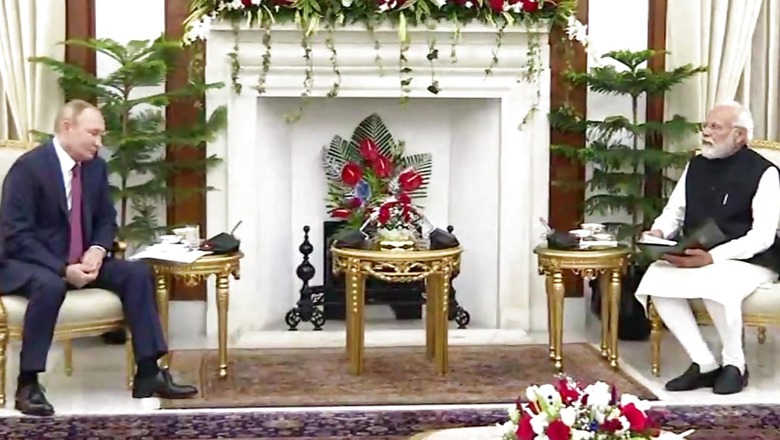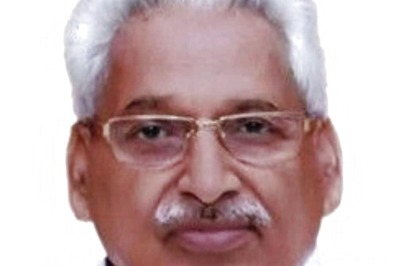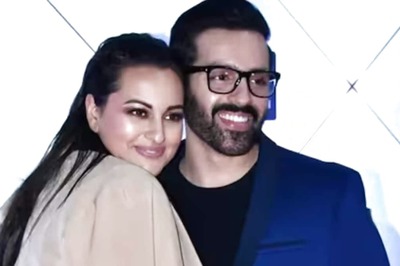
views
President Vladimir Putin’s short working visit to India for the 21st India-Russia summit on December 6 at the invitation of Prime Minister Modi went more or less as per script. It was rich in symbolism, productive and timely, yet did not do much to narrow the differences. Lurking in the shadows were the dragon as well as the bald eagle.
A wordy joint statement, comprising 99 paragraphs was issued upon conclusion of the visit, which ticked all the boxes, but clearly was long on intent and short on action. For the record, 28 agreements and memoranda of understanding (MOU) were signed many of which will lie dormant as in the past. The most significant agreement was on continuing Military-Technical Cooperation for another 10 years up to 2031.
Terming themselves as “major powers”, India and Russia characterised their relationship as an “anchor of global peace and stability”. They noted similarities of “approaches to their foreign policy priorities and reaffirmed their commitment for further strengthening of their Russia Special and Privileged Strategic Partnership.”
And on the issue of terrorism and Afghanistan, New Delhi and Moscow are now one, which represents a major success for Indian diplomacy. Until recently, Russia was taking a cue from Islamabad and Beijing, which are averse to India’s role in managing the Afghan situation.
The leaders noted a “convergence of views and interests” on Afghanistan and welcomed close coordination through the permanent consultative mechanism between the Security Councils of both countries. They spoke out unequivocally against the use of Afghanistan’s territory “for sheltering, training, planning or financing any terrorist groups including ISIS, Al Qaeda, LeT etc.” They also decided to provide immediate humanitarian assistance to the people of Afghanistan.
Speaking to the media separately, foreign minister Sergey Lavrov said that Russia had “every reason to believe” that India and Iran should be in the Extended Troika on Afghanistan to stabilise the country. He also agreed with India that “Taliban must deliver on their commitments” to establish an inclusive government and deal with the menace of terrorism and drug trafficking.
However, Lavrov minced no words in accusing the US of trying to undermine India Russia relations and forcing India to tow its line. He also remained highly critical of the Indo-Pacific construct and AUKUS, making common cause with China.
It would be recalled that at the Russian International Affairs Council last December, he had alleged that the US was trying to lure India into its camp through the QUAD, making it obvious that he was buying into Chinese narrative of an American grand design. In April 2021, he made it a point to travel to Islamabad from New Delhi—a practice that had long been given up by friendly countries. He further stated that Russia was ready to supply special military equipment to Islamabad.
The Joint Statement underlined that “military and military-technical cooperation has traditionally been the pillar” of bilateral partnership. Earlier in the day the sides reportedly concluded an important agreement to produce over half a million AK-203 assault rifles at Amethi, which would give a fillip to ‘Make in India’ initiative in the defence sector. A joint venture—called Indo-Russian Rifles Private Ltd (IRRPL)—has been set up for the purpose.
It is most significant that Putin’s visit materialised soon after the $5.5 billion S-400 anti-missile defence system deal signed in 2018 was operationalised. Foreign Secretary Harsh Vardhan Shringla confirmed that “supplies have begun this month, and will continue to happen.” The Soviet Union and now Russia remains India’s primary source of defence equipment and platforms. Moscow’s share has dipped to around 50 per cent from over 70 per cent in 20 years yet, according to Stockholm International Peace Research Institute, India has procured weapons worth $35 billion from Russia.
It is this S-400 deal that has raised Washington’s heckles notwithstanding India’s security compulsions or that India has contracted defense equipment worth $22 billion from the US in the last 10 years. The US has tried hard to prevent India from honouring the deal alluding to the possibility of imposition of Countering America’s Adversaries Through Sanctions Act (CAATSA) sanctions even though it is acknowledged that CAATSA was not meant to target India. And therein lies the irony!
Admiral JG Nadkarni provides a riveting account of India’s Russian connection. Until the early 1960s, the Indian Navy was more or less an extension of the Royal Navy, he writes. In 1964, India was extremely keen to build a submarine arm. Britain summarily rejected India’s request for submarines and ships under the American pressure. Miffed and disillusioned, India turned to the USSR and signed an agreement on September 1, 1965. Russia promptly supplied four submarines, five patrol vessels, two landing ships and some patrol boats.
India went ahead with S-400 missile deal asserting its strategic autonomy especially when it comes to national security. But apprehensions about new complications in the India-US ties persist if the latter imposes any punitive measures on India. And it is this transnationalism that distinguishes USSR/Russia from the US and UK. The US, like any major power, tends to be prescriptive which is not acceptable to India.
Russia, however, has mostly stood by India. During the Galwan standoff last year, at India’s request, Russia rushed ammunition and spares, much to the annoyance of China. But given the growing proximity between Moscow and Beijing, and the geopolitical flux, India can no longer be assured of Russian support, particularly if a conflict breaks out with China.
Nevertheless, in this multi-actor diplomatic tango, India and Russia have made a determined effort to infuse greater warmth and momentum in the relationship, which gives both sides much-needed leverage. Putin’s visit to New Delhi was only his second outing abroad, other than Geneva in June when he met US President Joe Biden, during the two-year COVID period.
It helps that Modi and Putin who have met some 20 times, enjoy a good equation and hold each other in respect. Even so, the much-anticipated and not too complicated Reciprocal Exchange of Logistics Agreement (RELOS), which would have been India 7th, could not be concluded. India and Russia have traditionally partnered well in areas like energy (hydrocarbon and nuclear), space and, of course defence, but are finding it difficult to open up new vistas of engagement. Bilateral trade is not picking up and investments remain sluggish, notwithstanding $15 billion of Indian FDI in the Russian hydrocarbon sector.
In 2017 Russia’s Rosneft acquired Essar Oil for $12.9 billion representing the biggest-ever Russian investment in India.
The in-person summit between the two leaders and the first ever 2 + 2 ministerial (defence and foreign) dialogue would certainly enhance mutual understanding. Yet the challenges and imponderables cannot be glossed over. The western pressure on Russia is unrelenting. India is arguably facing the toughest crisis in Ladakh. How the moving pieces would pan out eventually is anybody’s guess but all credit to Indian diplomacy for displaying remarkable chutzpah and admirable restraint.
The author is Former Envoy to South Korea and Canada and Official Spokesperson of the Ministry of External Affairs. The views expressed in this article are those of the author and do not represent the stand of this publication.
Read all the Latest Opinions here

















Comments
0 comment